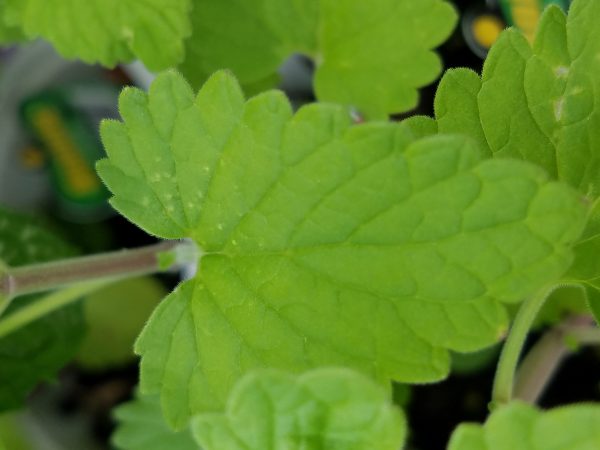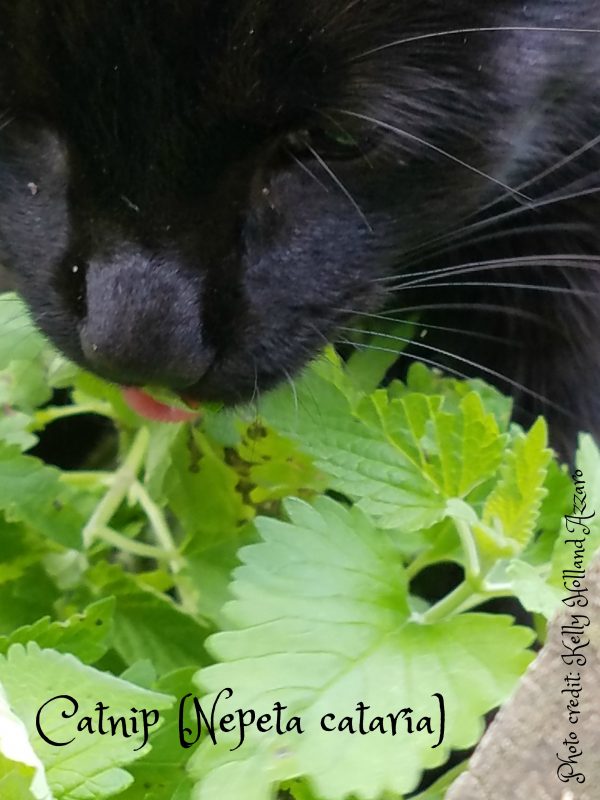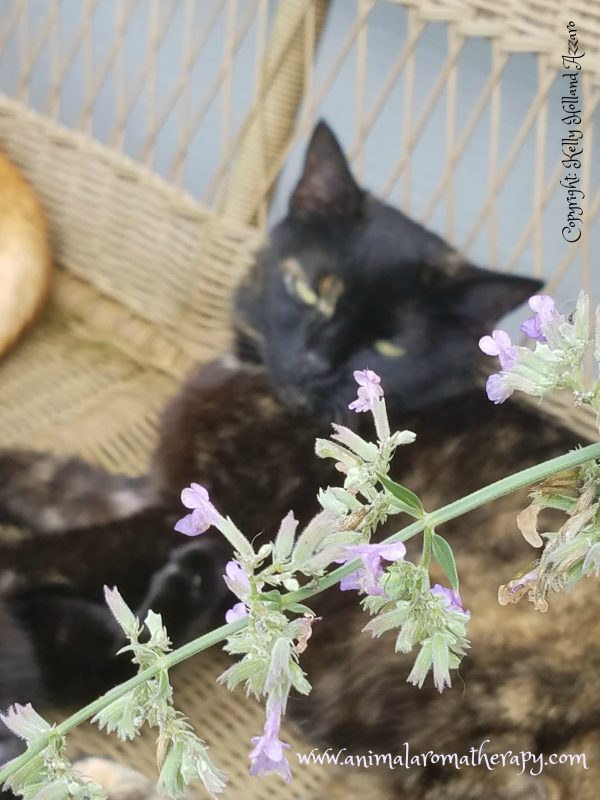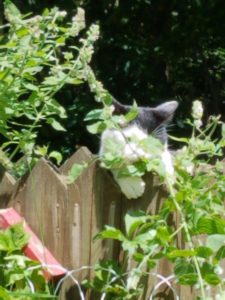
Image: Catnip (Nepeta cataria) Copyright 2020 Kelly Holland Azzaro (from our botanical garden)
Crazy for Catnip: Catnip Profile
By Kelly Holland Azzaro
To learn more about Kelly Holland Azzaro an Animal Aromatherapy Practitioner Program, please click here: www.animalaromatherapy.com
Catnip (Nepeta cataria) (flowers, leaves)
Binomial: Nepeta cataria L.
Botanical Family: Lamiaceae (Labiatae), Genus: Nepeta
Native Origin: Europe, Asia, Middle East
Cultivated: North America (in particular- the USA and Canada)
Common Name/s: Catnip, catmint, cat wort, field balm.
Botanical Synonyms: Nepeta cataria
Plant Part Used: aerial parts (flowers, leaves, stems). Both the leaves and stems contain a volatile oil known as nepetalactone.
Extraction Method: steam distillation, hydro-distillation.
Scent: light herbal mint aroma. A more potent scent is released when crushing the fresh leaves.
Varieties: include Nepeta cataria var. citriodora (or N. cataria subsp. citriodora), or “lemon catnip”.-Kathi Keville (2016) “The Aromatherapy Garden“.
Interesting notes: “The name Nepeta is believed to have come from the town of Nepeta in Italy. Cataria is thought to have come from the Latin word for cat.“-Gaia Herbs.

And, did you know that not all cats will go crazy for catnip-or do they?
A 2017 research study conducted, wakens one to rethink what was thought to be that not all cats (due to genetics) may react to catnip’s chemical components. However, from this published abstract the following is suggested:
“These results suggest that all cats respond to catnip but they express it actively, passively or with a combination of both types of responses, which mainly depends on age and sex, and early gonadectomy to a much less extent.“-Science Direct (Elsevier, Vol. 142, 2017 ) [¹]

Cultivation
A perennial plant that thrives during spring into mid-autumn. Catnip plants are drought tolerant (and require good drainage to avoid getting soggy roots). Nepeta species love sunshine, but can also do well in mild shaded areas as long as the plant has access to sunlight for at least six or more hours. Catnip is considered to be an invasion plant and since it is part of the Lamiaceae botanical family-as are mint plants, be sure to map out where you’d like for the catnip to grown (in a separate garden, pots, or larger raised beds secured with wooden boards, etc.) to ensure it doesn’t take over too much garden space-unless, of course, if that is your intention (or, should I say, your cat’s intention!), to have a specific catnip garden just for your cats! (See bottom section for photos on ideas to start your own catnip garden).
Catmint (Nepeta spp.)
With every growing season, it produces larger size downy soft, heart-shaped leaves and beautiful, light purple-speckled flowers. The plant reseeds itself and can grow from 1 to 3-3.5 feet tall. Starter plants are usually available at a local nursery, farmer’s markets, and or ask a gardener friend for a few stems with healthy roots to replant and start your own catnip garden. This plant is pretty resilient and will serve you and your outdoor cats during spring, summer, and autumn.
This photo shown above is of our Catmint plants. Catmint is not as potent in scent as catnip, though it does have a very soft catnip-minty aroma. Cats do not seem to be as attracted to it, but, I do find that it provides a nice shady overgrown for an afternoon catnap!
Chemistry Tidbit:
The two main components of catnip essential oil are the terpenoid Nepetalactone isomers (up to 80+%), and Nepetalic acid (up to 40+%). With the main constituent nepetalactone considered as one responsible for CNS (Central Nervous System) effects. [²]
With the hydrosol “carophyllene oxide, and possibly nepetalactone isomers.”-[³] Harman, Ann
The chemical interacts as a vapor at the olfactory epithelium. [⁴]
Therapeutic Properties:
- Antispasmodic (digestive)
- Calming (nervous system)
- Carminative (digestive system)
- Diaphoretic (promotes sweating)
- Repellent (gnats, mosquitoes)
- Sedative (nervous system)
- Stimulating (felines)
- Resonates with the TCM (Traditional Chinese Medicine) Meridians: Heart, Lungs, Stomach, Triple Warmer.
Traditional Uses:
- Bug repellent: research has shown its effectiveness in particular with cockroaches, mosquitoes, stable flies, ixodid ticks, and poultry mites. (See research links at end section).
- Tension, stress, anxiousness from feeling uptight, and overwhelmed (dried herb for tea, hydrosol).
- Catnip tisane (herbal tea), tincture, and topical compress have been used for both digestive and nervous system support.
- Spray hydrosol onto cotton cat toys to freshen dried catnip herb.
- Be mindful when applied topically-you may find yourself being followed by a few felines!
Hydrosol Uses:
The use of the hydrosol is a safe and effective way to incorporate catnip for use with humans and their animal friends. The hydrosol is readily available and easy to use in a mist spray bottle to spritz onto outdoor clothing when gardening, hiking, and camping to help keep biting bugs at bay.
Another fun way to try the hydrosol is to pour into a mini icecube tray and freeze. Use a frozen cube wrapped in a cotton cloth to apply to bug bites/stings, nape of the neck to cool off, and to the forehead. I have also placed a small ice cube into a glass of ice tea for a refreshing and relaxing drink to cool down after a day of gardening.
The hydrosol can also be used with a compress to apply to the skin if feeling overheated due to too much fun in the sun, or to the forehead for relief from a headache (tension and heat-induced).
Essential Oil Use:
The pure essential oil is more potent and when diluted with vegetable oil or unscented lotion, to apply topically, has been found by some individuals to be quite useful during nature walks when pesty biting bugs are near. If incorporating for use to help with biting flies with larger farm animals (horses, cattle, alpacas, llamas, goats, and sheep), both the essential oil and the hydrosol may be effective in a blend, and stick with the use of the diluted hydrosol for dogs and cats.
Safety Cautions:
With the essential oil- use caution with topical application to the skin. Properly dilute with a base/vegetable oil to avoid possible skin sensitization issues. The dried herbal form is best suited for internal consumption when made into tea. Fresh plant flowers and leaves may also be used for their aromatic properties via simple inhalation. Gently rub the plant material back and forth with your fingers, and take a whiff of the herbaceous scent. Just be sure to wash your hands well (and avoid rubbing or touching your eyes) after you are finished working with the plants/fresh/dried herbs/essential oil and or hydrosol.
With all essential oils, herbs, and hydrosols, be sure to keep all out of reach of children and pets. Store out of direct sunlight, and be sure to always use fresh products. The herb and hydrosol are prone to mildew if not properly stored and the essential oil over time is prone to oxidation. If unsure of use, consult with a qualified aromatherapist/herbalist for more information.
Price Point:
low to moderately priced. The pure essential oil is more expensive than the hydrosol, and, at times can be difficult to find for purchase. The fresh herb plants are usually $3-5.00 each, and all you need are a few to get started and then you will have plenty for repotting and sharing with others.
A Magical Catnip Garden for Our Outdoor Cats

I love when synchronicity plays a part in magical experiences. One day we were looking for garden statues for our botanical garden and a local business owner who makes these was in the process of clearing out older stock along with some wooden planters I noticed tossed to the side. I asked what they were used for and he shared how he made the planters to use for starter boxes to hold small cypress trees while they grew taller to then plant in his yard for use as a privacy fence. I remarked how creative he is. He then gifted us the planters saying he knew they were going to put to good use. How wonderful for us (and our cats)!
The planters are very sturdy and the perfect size to start a mini garden. When I first saw the planters, I started thinking ‘how can I put these to good use?’ I thought, perhaps they’d make for a nice border when lined up next to each other and then top them with some nice aromatic plants. One of our outdoor cats immediately jumped in the smaller of the empty planters-and voila‘, the idea for a separate mini garden for the cats came to mind.
 Catnip being the first plant to place into two of the planters, and catmint spp. in another, with the last planter, left empty because that one is a favorite for playing hide and seek. Over the last two years, the catnip plants have increased in size and provide a special place for the cats to experience catnip bliss. I found that by visiting the planters that I’m followed by my feline friends and it has now become an important ritual that we all enjoy, and, has also increased their level of confidence and social camaraderie amongst each other.
Catnip being the first plant to place into two of the planters, and catmint spp. in another, with the last planter, left empty because that one is a favorite for playing hide and seek. Over the last two years, the catnip plants have increased in size and provide a special place for the cats to experience catnip bliss. I found that by visiting the planters that I’m followed by my feline friends and it has now become an important ritual that we all enjoy, and, has also increased their level of confidence and social camaraderie amongst each other.
By spending time outdoors, within the beauty of nature, and, most importantly-with our feline friends brings such magic to our days. For myself, I find it very calming, grounding, and very uplifting for my spirit.
Taking time away from electronic devices, and absorbing the healing power of the sunlight vs being a sponge for electromagnetic waves is certainly something I look forward to as part of my self-care. I hope that our cat’s catnip garden will inspire you to do the same.
Even if you are not a caregiver to outdoor cats, creating a mini aromatic garden to experience a small part of nature is still a truly joyful gift to give yourself and your family. But, be forewarned if you do decide to plant catnip for your own use, you may find yourself some new furry friends to spend time with!

References:
[1] Science Direct (Elsevier) Abstract 2017
[2] Tisserand, R. and Young, R., Essential Oil Safety, 2nd Ed., 2014
[3] Harman, Ann, From Harvest to Hydrosol, First Ed., 2015
[4] Science Direct, Elsevier, Research Abstract (July 1985) https://doi.org/10.1016%2FS0163-1047%2885%2991151-3
Research Abstracts
(Last accessed July 2020)
Essential oil composition of five Nepeta species cultivated in Lithuania and evaluation of their bioactivities, toxicity, and antioxidant potential of hydrodistillation residues. (April 2019).
Insect Repellents: An Updated Review for the Clinician. Quoc-Bao D Nguyen, Mai-Anh N Vu, Adelaide A Herbert (November 2018)
Active and passive responses to catnip (Nepeta cataria) are affected by age, sex, and early gonadectomy in male and female cats. Science Direct (Elsevier, September 2017)
Nepetalactones from the essential oil of Nepeta cataria represent a stable fly feeding and oviposition repellent. (June 2012).
Repellent activity of catmint, Nepeta cataria, and iridoid nepetalactone isomers against Afro-tropical mosquitoes, ixodid ticks, and red poultry mites. (November 2010)
Repellency of wax-based catnip-oil formulation against stable flies. (Dec. 2010).
Behavioral responses of catnip (Nepeta cataria) by two species of mosquitoes, Aedes aegypti and Anopheles harrisoni, in Thailand. (December 2008)
Sensory and instrumental evaluation of catnip (Nepeta cataria L.) aroma. (June 2003).
Science Direct (Elsevier) Abstract: Analysis of catnip reaction: mediation by olfactory system, not the vomeronasal organ (July 1985)
Benjamin L.
Mitzi G. Leedy
PubChem Nepetalactone Structure Images
Source link
[ad_2]
source https://earn8online.com/index.php/139396/crazy-for-catnip-catnip-profile/
No comments:
Post a Comment